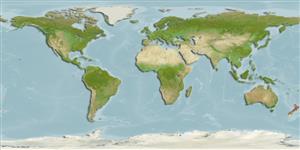>
Blenniiformes (Blennies) >
Tripterygiidae (Triplefin blennies) > Tripterygiinae
Etymology: Bellapiscis: Latin, bellum = war + Latin, piscis = fish.
Environment: milieu / climate zone / depth range / distribution range
Ekologi
marina bottenlevande; ej vandrande; djupintervall 0 - 5 m (Ref. 13227). Temperate
Utbredning
Länder | FAO områden | Ekosystem | Förekomster | Point map | Utplanteringar | Faunafri
Southwest Pacific: New Zealand.
Length at first maturity / Size / Vikt / Age
Maturity: Lm 4.3, range 4 - 4.5 cm
Max length : 6.0 cm SL hane/ej könsbestämd; (Ref. 13227); rapporterad maxålder: 3.00 år (Ref. 13227)
Short description
Morfologi | Morfometri
Taggstrålar i ryggfenan (totalt): 18 - 21; Mjukstrålar i ryggfenan (totalt): 10-15; Taggstrålar i analfenan 2; Mjukstrålar i analfenan: 17 - 22. With 17-22 soft anal fin rays, 17-25 lateral line scales, 35-42 +1 total lateral scale rows, and the body with an irregular or without a checker-board pattern, extending to level of belly.
Facultative air-breathing in the genus (Ref. 126274); Adults are found predominantly in tide pools and upper subtidal areas. Are solitary. They feed mainly on amphipods, isopods, polychaetes, and small gastropods. Males may defend small breeding territories during the breeding season (Ref 13227). Eggs are hemispherical and covered with numerous sticky threads that anchor them in the algae on the nesting sites (Ref. 240). Larvae are planktonic which occur primarily in shallow, nearshore waters (Ref. 94114).
Eggs are laid in empty barnacle shells found in rocky areas. The nest is guarded by the male while the eggs are covered with water. Juveniles are found in the intertidal region between August and December (Ref. 13227).
Fricke, R., 1994. Tripterygiid fishes of Australia, New Zealand and the southwest Pacific Ocean (Teleostei). Theses Zool. 24:1-585. (Ref. 13227)
IUCN Red List Status (Ref. 130435)
Warning: mysqli::__construct(): (HY000/1040): Too many connections in /var/www/html/includes/func_getlabel.php on line 46
Can't connect to MySQL database (fbapp). Errorcode: Too many connections
